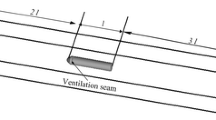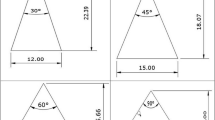Abstract
Previously it was assumed that the pressure within the cavity or on the cavity surface remained constant and the vapor pressure of clean water at 20°C and 0 m altitude was utilized as the computational boundary for cavitating flows in hydraulic turbomachinery. Cavitation was confused with vaporization, and the effect of water quality on cavitation pressure characteristics was not taken into account. In recent years, lots of experiments of cavitation pressure characteristics of different water qualities including different sand concentrations of sand water and different altitudes of clean water have been performed by the authors, and the important influences of water quality on cavitation pressure characteristic have been validated. Thus the water quality should be involved in the cavitating flows computation. In the present paper, the effect of water quality on the cavitation pressure characteristic is analyzed and the computational method and theory of cavitating flows for hydraulic turbomachinery that considers the influence of water quality are proposed. The theory is suitable for both the potential flow method and the two-phase flow method for cavitating flows simulation. Finally, the validation results for cavitating flows in a hydraulic turbine indicate the significant influences of water quality on the cavitating flow performance.
Similar content being viewed by others
References
Gurevich M I. Theory of Jets in Ideal Fluids. London: Academic Press, 1965. 568
Lavrentev M A, Shabat B V. Hydrodynamics Problems and Their Mathematical Models. 2nd Ed (in Russian). Moscow: Izdatel’stvo Nauka, 1977. 408
Gahov F D. Boundary Value Problems (in Russian). Moscow: Fizmatgiz, 1958
Brennen C. A numerical solution of axisymmetric cavity flow. J Fluid Mech, 1969, 37: 671–688
Yamaguchi H, Kato H. On application of nonlinear cavity flow theory to thickfoil sections. The 2nd International Conference on Cavitation, Edinburgh, 1983
Kinnas S A, Fine N E. A numerical nonlinear analysis of the flow around two- and three-dimensional partially cavitating hydrofoils. J Fluid Mech, 1993, 254: 81–151
Finzel R, Will G. Zur Berechung der Stromung in Kreisel pumpen laufradern bei Kavitation. Pumpen und Verdichtinfor-mationen, 1972, 2: 36–41
Couston M, Eremeef L R. Quasi three-dimensional analysis for solving cavitation problems at hydropower plants. The 8th International fluid Conference, Budapest, 1980
Ito J L. Calculation of partially cavitating thick hydrofoil and examination of flow model at cavity termination. Proceedings of International Symposium on Cavitation, Sendai, Japan,1986
Chen Y, Heister S D. A numerical treatment for attached cavitation. J Fluids Eng, 1994,116: 613–626
Deshpande M, Feng J, Merkle C L. Numerical modeling of the thermodynamic effects of cavitation. J Fluids Eng, 1997,119: 420–437
Kubota A, Kato H, Yamaguchi H. A new modeling of cavitating flows: A numerical study of unsteady cavitation on a hydrofoil section. J Fluid Mech, 1992, 240: 59–96
Delannoy Y, Kueny J L. Two phase flow approach in unsteady cavitation modeling. Cavitation and Multiphase Flow Forum, 1990, 98: 153–158
Knapp R T, Daily J W, Hammitt F G. Cavitation. New York: McGraw-Hill, 1970
Chang J S. The important effect of the state of water quality on cavitation pressure performance of the pump device (in Chinese). Drain Irrig Mach, 2008, 26(2): 23–26
Briggs, Lyman J. Maximum superheating of water as a measure of negative pressure. J Appl Phys, 1955, 26: 1001–1003
Dajiong L, Jianguo G. Study on bubble-laser chamber (in Chinese). Chinese Sci Bull, 1973, 18(1): 22–24
Chang J S. The decisive effect of cosmic-ray ionization on cavitation pressure characteristic of clean water. Sci China Ser E-Tech Sci, 2009, 52(6): 1804–1808
Yang J L, Wang J, Chang J S. Effect of sediment-laden flow on cavitation pressure inside of hydraulic machineries in Wangjiazhai Hydropower Station (in Chinese). Water Resou Hydrop Eng, 2005, 36: 64–67
Wang L, Zhu R S, Chang J S. Effect of sediment-laden flow on cavitation pressure characteristic of hydraulic machineries in Qingtongxia and Babanxia hydropower stations(in Chinese). J Hydroelec Eng, 2008, 27(4): 44–47
Pfleiderer C, Petermann H. Sfrömungsmaschinen. Berlin: Springer Verlag, 1964. 40–45
Sfepanoff A J. Centrifugal and Axial Flow Pumps. 2nd ed. New York: John Willey, 1957. 258–272
Sedov L I. Two-Dimensional Problems in Hydrodynamics and Aerodynamics. Moscow: Izdatel’stvo Nauka, 1980. 221–231
Furuga O. Nonlinear theory of partially cavitating cascade flows. IAHR Symposium, Tokyo, Japan, 1980
Lemonnir H, Rowe E. Another approach in modeling cavitating flows. J Fluid Mech, 1988, 195: 557–580
Nishiyama T, Ito J. Calculation of partially cavitating hydrofoil by singularity method: Part 1, Isolated hydrofoil). Trans JSME Mech Eng, 1977, 43(370): 2165–2174
Turlin M, Hsu C. New application of cavity flow theory. The 13th Symposium Naval Hydrodynamics, Tokyo, Japan, 1980
Iga Y, Nohml M, A Goto, et al. Numerical analysis of cavitation instabilities arising in the tree-blade cascade. J Fluids Eng, 2004, 126: 419–429
Senocak I, Shyy W. Numerical simulation of turbulent flows with sheet cavitation. Proceedings of the 4th International Symposium on Cavitation. CAV 2001, Pasadena, CA
Abgrall R, Saurel R. Discrete equations for physical and numerical compressible multiphase mixture. J Comput Phys, 2003, 186: 361–369
Singhal A K, Athavale M M, Li H Y, et al. Mathematical basis and validation of the full cavitation model. J Fluids Eng, 2002, 124: 617–623
Mejri I, Bakir F, Rey R, et al. Comparison of computational results obtained from a homogeneous cavitation model with experimental investigations of three inducers. J Fluids Eng, 2006, 128: 1308–1323
Watanabe T. Development of a marine propeller simulator considering wake and cavitation (in Japanese). M.S. Thesis. Tokyo: University of Tokyo, 2004
Guennoun F, Farhat M, Bouziad Y A, et al. Experiment investigation of a particular traveling bubble cavitation. Fifth International Symposium on Cavitation, Osaka, Japan, 2003
Kunz R E, Boger D, Chyczewski T, et al. Muti-phase CFD analysis of natural and ventilated cavitation about submerged bodies. 3rd ASME/JSME Joint Fluids Engineering Conference, San Francisco, 1999
Yakhot V, Orszag S A, Tangham S, et al. Development of turbulence models for shear flows by a double expansion technique. Phys Fluids, 1992, 7: 1510–1520
Author information
Authors and Affiliations
Corresponding author
Rights and permissions
About this article
Cite this article
Wang, L., Chang, J. Computational theory of cavitating flows for hydraulic turbomachinery with consideration of influence of water quality. Sci. China Technol. Sci. 53, 3341–3348 (2010). https://doi.org/10.1007/s11431-010-4149-3
Received:
Accepted:
Published:
Issue Date:
DOI: https://doi.org/10.1007/s11431-010-4149-3




